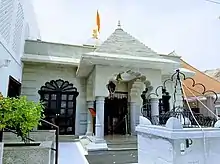Hinduism in Arab states
Millions of members of the Indian diaspora, of different religions, reside and work in Arab states of the Persian Gulf. Many of them are Hindu. Many came due to the migration of Indians and Nepalese expatriates and employees to the oil-rich states around the Persian Gulf.
| Hinduism by country |
|---|
  |
| Full list |
Hindu temples have been built in Bahrain, the United Arab Emirates, Yemen, and Oman.[1]
Estimated Hindu population by country
The estimated figures for the Hindu population in 2020, among some Arab countries was as follows:
- United Arab Emirates 660,000[2][3]
- Saudi Arabia 440,000[4]
- Qatar 360,000[5][6][7]
- Kuwait 330,000[8]
- Yemen 200,000[9]
- Oman 190,000[10][11]
- Bahrain 150,000[12]
- Jordan <10,000[13]
- Egypt <10,000[14]
- Iraq <10,000[15]
- Israel <10,000[16]
- Lebanon <10,000[17]
- Syria <10,000[18]
- Palestine <10,000[19]
Approximately 2.4 million
The number of Hindus in other Arab countries, including the countries of the Levant and North Africa, is thought to be negligible, though Libya has an Indian Nepali community of about 10,000[20] individuals (in 2007), many of whom are likely to be Hindu. It is not known whether any Hindu temples exist in these countries.
Historical background
Indian settlers came to live in Oman, creating settlements and practicing Hinduism. Arab sailors were using the southwest monsoon winds to trade with western Indian ports before the first century CE. An Arab army conquered Sindh in 711 and Arab traders settled in Kerala in the 6th century. In the opposite direction, medieval Gujaratis, Kutchis, and other Indians traded extensively with Arab and Somali ports, including Hormuz, Salalah, Socotra, Mogadishu, Merca, Barawa, Hobyo, Muscat and Aden. Arab merchants were the dominant carriers of Indian Ocean trade until the Portuguese forcibly supplanted them at the end of the 15th century. Indo-Arabian links were renewed under the British Empire, when many Indians serving in the army or civil service were stationed in Arab lands such as Sudan. The current wave of Indian immigration to the Arab states of the Persian Gulf dates roughly to the 1960s. Hinduism is also one of the fastest growing religions in the Middle East,[21] mainly due to immigration from the Indian Subcontinent.
In 2001, Belgian speleologists found a large number of inscriptions, drawings and archaeological objects on the Socotra island in Yemen[22][23] left by sailors who visited the island in the 1st century BC to 6th century AD and most of the texts found were written in the Indian Brahmi script.[24]
Egypt
There is a small community of Indians in Egypt, the majority of whom are presumed to be adherents of Hinduism.[25]
United Arab Emirates
South Asians in the United Arab Emirates (UAE) constitute the largest ethnic group in the country.[26] Over 2 million Indian migrants (mostly from the southern states of Kerala, Andhra Pradesh, Coastal Karnataka and Tamil Nadu) are estimated to be living in the UAE, constituting 28% of the total population of the Emirates as of 2017.[27] A majority of Indians live in the three largest cities of the UAE — Abu Dhabi, Dubai and Sharjah. From the estimated 2 million migrants, 1 million are from Kerala and 450,000 from Tamil Nadu, thus constituting a majority of the Indian community in the UAE. The population of Indian migrants in the UAE had grown from 170,000 in 1975 to an estimated value of 750,000 in 1999. By 2009, this value had grown to an estimated value of 2 million. A majority of Indians in the UAE (approximately 50%—883,313 in 2011) are from the South Indian state of Kerala, followed by migrants from Tamil Nadu. The majority of Indian migrants to UAE are Muslim (50%), followed by Christian (25%) and Hindu (25%). Estimates suggest Hindu population in UAE to be anywhere from 6-10%.
Temples
Despite a sizable of the population practicing the Hindu faith, there is currently just one Hindu temple in the two largest sheikhdoms. The Hindu Temple, Dubai (locally referred to as Shiva and Krishna Mandir) has been pointed out as just a small prayer hall operating on the upper floor of a rented commercial building, with two altars.
Permitted to be built in 1958, the small temple had become a foreign policy issue during the visit by Prime Minister Narendra Modi to the UAE in late 2016.
Instead, Hindus living in Abu Dhabi and Dubai practice their religion within their homes. The first Hindu temple in Abu Dhabi is currently under construction.[28] The new temple, BAPS Shri Swaminarayan Mandir Abu Dhabi, had its foundation stone laying ceremony in April, 2019.[29][30]
There are two operating cremation facilities for the Hindu community, one in Abu Dhabi and one in Dubai.
Oman

Oman has an immigrant Hindu minority. The number of Hindus has declined in the 20th century although it is now stable. Hinduism first came to Muscat in 1507 from Kutch. The original Hindus spoke Kutchi language. By the early 19th century there were at least 4,000 Hindus in Oman, all of the intermediate merchant caste. By 1900, their numbers had plummeted to 300. In 1895, the Hindu colony in Muscat came under attack by the Ibadhis. By the time of independence, only a few dozen Hindus remained in Oman. The historical Hindu Quarters of al-Waljat and al-Banyan are no longer occupied by Hindus. The most prominent immigrant Hindus (Kutchi), are Khimji Ramdas, Dhanji Morarji, Ratansi Purushottam and Purushottam Toprani.[31] The only Hindu crematorium is located in Sohar, northwest of Muscat.
Temples
Hindu temples once located in Ma'bad al Banyan and Bayt al Pir, no longer exist. The only active Hindu temples today are the Shiva temple complex in Muscat (locally known as Motishwar Mandir,[32] and the Krishna temple located in Darsait.[33]
Saudi Arabia
Saudi authorities interpret Hindu icons as idols, and idol worship is strongly condemned in Sunni Islam. This is likely the foundation for the stringent position of Saudi authorities when it comes to Hindu religious practice.[34] Hindus are not permitted to build temples though many of them worship inside rented apartments/houses in Saudi Arabia. Celebrations of all festivals are also held only indoors. Further permission is asked for outdoor activities for certain areas. According to US State Department,[35] a Sunni Muslim male in Saudi Arabia receives the full award for accidental death or injury compensation as required by Sharia, a Jewish or Christian male receives 50 percent of the compensation a Muslim male would receive, and Hindus (and others such as Buddhists, and Sikhs) are only entitled to receive 1/16 the amount a male Sunni Muslim would receive.[36]
Similarly, only the testimony by Sunnis is accepted as reliable, while the testimony of Hindu witnesses (and other non-Muslim religions) are often ignored in courts of law altogether, as stipulated in Sharia. In general, in Saudi courts, a woman's testimony is worth only half that of a man's, and a non-Muslim's (Hindu) testimony is worth less than that of a Muslim's.[35]
Qatar
Hindus make up 13.8% of Qatar. There are an estimated 351,210 Hindus in the country.[5][6] Many Hindus are from Nepal.
Hindu temples
- BAPS Shri Swaminarayan Mandir Abu Dhabi in Abu Dhabi, UAE
- Motishwar Shiv Mandir in Muscat, Oman
- Shiva and Krishna Mandir in Dubai, UAE
- Shrinathji Temple, Bahrain
References
- "Hindu temples of Gulf countries: more exist than you imagined". catchnews. Retrieved December 20, 2016.
- "United Arab Emirates". U.S. Department of State.
- http://www.globalreligiousfutures.org/
- http://www.globalreligiousfutures.org/
- Global Religious Landscape. Pew Forum.
- "Population By Religion, Gender And Municipality March 2004". Qatar Statistics Authority. Archived from the original on 2013-05-18.
- http://www.globalreligiousfutures.org/
- http://www.globalreligiousfutures.org/
- http://www.globalreligiousfutures.org/
- "Middle East OMAN". CIA The World Factbook.
- http://www.globalreligiousfutures.org/
- http://www.globalreligiousfutures.org/
- http://www.globalreligiousfutures.org/
- http://www.globalreligiousfutures.org/
- http://www.globalreligiousfutures.org/
- http://www.globalreligiousfutures.org/
- http://www.globalreligiousfutures.org/
- http://www.globalreligiousfutures.org/
- http://www.globalreligiousfutures.org/
- "Indian Community in Libya" (PDF). archive. Archived from the original on October 4, 2007. Retrieved December 20, 2016.CS1 maint: bot: original URL status unknown (link)
- "The Hindu Diaspora In The Middle East". kashmir blogs-Truth about Kashmir-" kashmir blog"".
- "La grotte sanctuaire de Suqutra". Archéologia (in French) (396). 26 March 2020.
- Robin, C.; Gorea, M. (2002). "Les vestiges antiques de la grotte de Hôq (Suqutra, Yémen) (note d'information)". Comptes rendus des séances de l'Académie des Inscriptions et Belles-Lettres (in French). 146 (2): 409–445. doi:10.3406/crai.2002.22441.
- Bukharin, Mikhail D.; De Geest, Peter; Dridi, Hédi; Gorea, Maria; Jansen Van Rensburg, Julian; Robin, Christian Julien; Shelat, Bharati; Sims-Williams, Nicholas; Strauch, Ingo (2012). Strauch, Ingo (ed.). Foreign Sailors on Socotra. The inscriptions and drawings from the cave Hoq. Bremen: Dr. Ute Hempen Verlag. p. 592. ISBN 978-3-934106-91-8.
- Color Me Indian Egypt Today - June 2009. archive url:
- "UAE´s population – by nationality". bq magazine. April 12, 2015. Archived from the original on March 21, 2017. Retrieved December 20, 2016.
- "India is a top source and destination for world's migrants". Pew Research Center. Retrieved 2019-09-09.
- Bhattacherjee, Kallol (6 February 2018). "PM to lay foundation stone of temple in UAE". The Hindu. Retrieved 6 February 2018.
- "First Hindu Mandir In Abu Dhabi, UAE, To Be Built By BAPS Swaminarayan Sanstha | Indo American News". www.indoamerican-news.com. Retrieved 2018-05-15.
- "First Hindu Temple's Foundation Ceremony Laying Ceremony in Abu Dhabi". Gulf News.
- J.E. Peterson,Oman's diverse society: Northern Oman, Middle East Journal, Vol. 58, Nr. 1, Winter 2004
- "Shri Shiva Temple".
- "Shri Krishna Temple".
- Marsh, Donna (May 11, 2015). Doing Business in the Middle East: A cultural and practical guide for all business professionals. Little, Brown Book Group. ISBN 9781472135674. Retrieved 28 February 2020.
- International Religious Freedom Report - Saudi Arabia State Department of the United States (2009)
- Saudi Arabia - Religious Freedom Report U.S. State Department (2012), pp. 4
